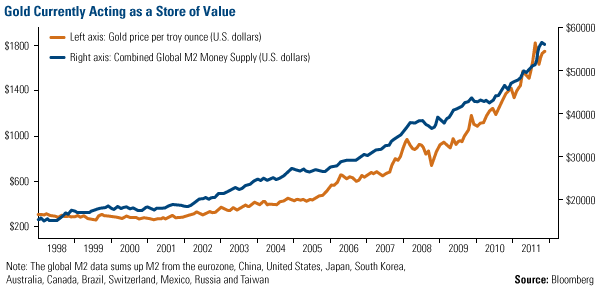Over the past two months, there has been a full percentage point increase in the yield on 10-year U.S. Treasuries. This is the latest sign that inflation is here.
During this same period of time, gold has dropped from around $1,380 to $1,230 – an 11% decline. The move has many investors scratching their heads, since gold has historically been considered a hedge against inflation and a growing money supply.
But don't be fooled by short-term gold-price volatility. We have inflation today, properly defined as an increase in money supply. Most investors and economists mistakenly focus on consumer prices.
Not withstanding the recent price decline, gold is indeed an inflation hedge, and a very good one when long-term trends are considered.
The graph below demonstrates gold's ability to hedge money-supply inflation. Going back to 1998, you can see that the price of gold has increased in near-lockstep with the growth in the world's money supply.

Gold is a good inflation hedge because its price appreciates with money-supply growth. But gold has one major shortcoming: it doesn't generate any cash flow, and that's a weakness because it limits its ability to generate wealth.
Given the 30% decline of gold from $1,800 – during a time when money supply continues to grow at a rapid pace – investors have good reason to be concerned about gold’s ability to provide protection, or create wealth.
Given this weakness, there is a far better way to hedge against inflation. It maintains purchasing power while building wealth and generating investment income.
That far superior solution is “dividend growers.”
Now, dividend growers shouldn’t require any introduction to Daily Profit readers. But for new readers, these are companies that consistently raise their dividend payments and pay their shareholders larger profits year after year.
The beauty in dividend-growth stocks is that ever year shareholders can expect to earn a little bit more. Think of it as a consistent 5 – 15% raise. What's more, the better dividend-growth stocks supply cash at a rate that maintains or even exceeds the inflation rate.
Oil giant ExxonMobil (NYSE: XOM) is an enlightening example of the ability of dividend-growth to hedge inflation while simultaneously building wealth.
ExxonMobil has increased its annual dividend at an average annual rate that roughly matches the average annual growth in the money supply. Over the 12 years ending in 2012, the world's money supply and ExxonMobil's annual dividend have increased at roughly the same 10% annually.
Over the same period, ExxonMobil's share price has appreciated at roughly 8% annually. As the company increased its earnings and dividends, investors bid up the price of the underlying shares.
Gold also did its job. The gold price appreciated at an average annual rate of roughly 13.5% (before the 2013 sell-off). But when you couple ExxonMobil's share-price appreciation with its dividend payout, the stock was a superior investment to gold with an average annual return of 18%.
Now, the past dozen years is a snapshot of time. But when the time frame is expanded, ExxonMobil shines even brighter.
In 1971, when the United States officially abandoned the gold standard, you could have bought an ounce of gold for $40 an ounce and share of ExxonMobil for $2.30 (split adjusted). Through 2012, the gold price appreciated at a 9.5% average annual rate. Meanwhile, a share of ExxonMobil appreciated at a 9.2% average annual rate.
But ExxonMobil's dividend growth was the great differentiator. The company has raised its dividend annually for the past forty years. This year, it raised its annual dividend 10% to $2.52 per share.
And here's where it gets really interesting.
ExxonMobil has returned to investors the 1971 purchase price many times over. Today, it returns the 1971 purchase price in dividends alone every year. Anyone who purchased a share of ExxonMobil in 1971 is generating annual income that exceeds 100% on the investment. You can read more about 100% annual returns here.
Now that's an inflation hedge extraordinaire!
Don't misunderstand, I'm not suggesting sell all gold and go all-in on dividend-growers. Gold still has a place in many investment portfolios as a “hard asset.”
But if you want to maintain purchasing power while simultaneously building wealth in an inflationary environment, no investment hedges inflation and builds wealth like a portfolio of quality dividend-growers.
|
Further Reading: Partner with an American Oil and Gas Pipeline Company American oil and gas is flowing – breaking decades long production records. But the safest way to profit isn't from explorers, producers, drillers or land owners. It's from the pipeline companies that move oil and gas from well-head to refinery. And with production slated to increase for years to come, these companies will see demand rise for their limited pipeline capacity. Click here to read my full write-up on two American pipeline stocks paying big (and growing) dividends. |
 Facebook
Facebook
 Twitter
Twitter